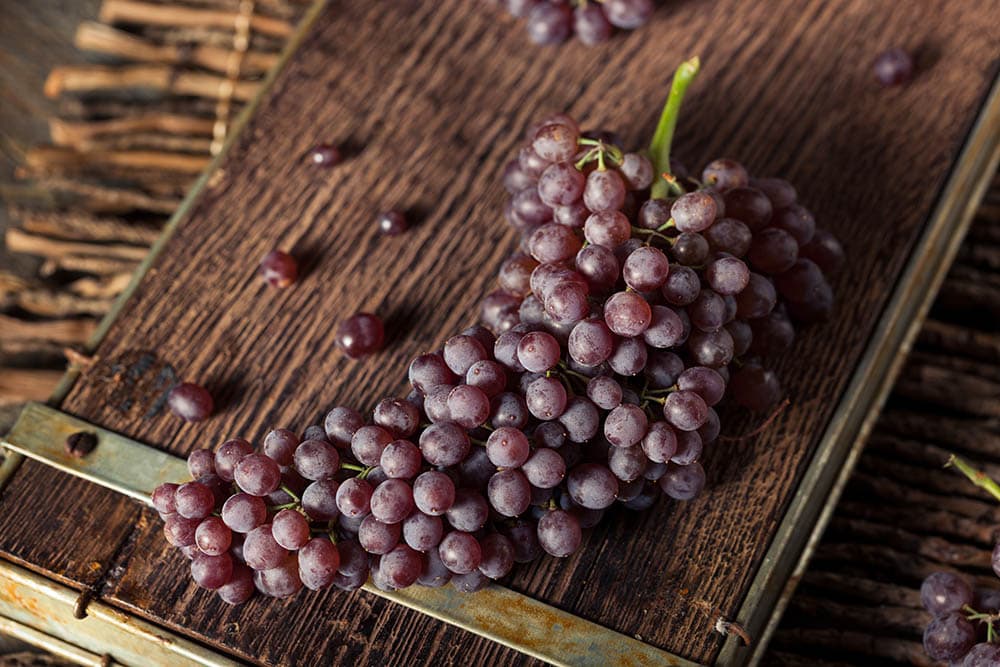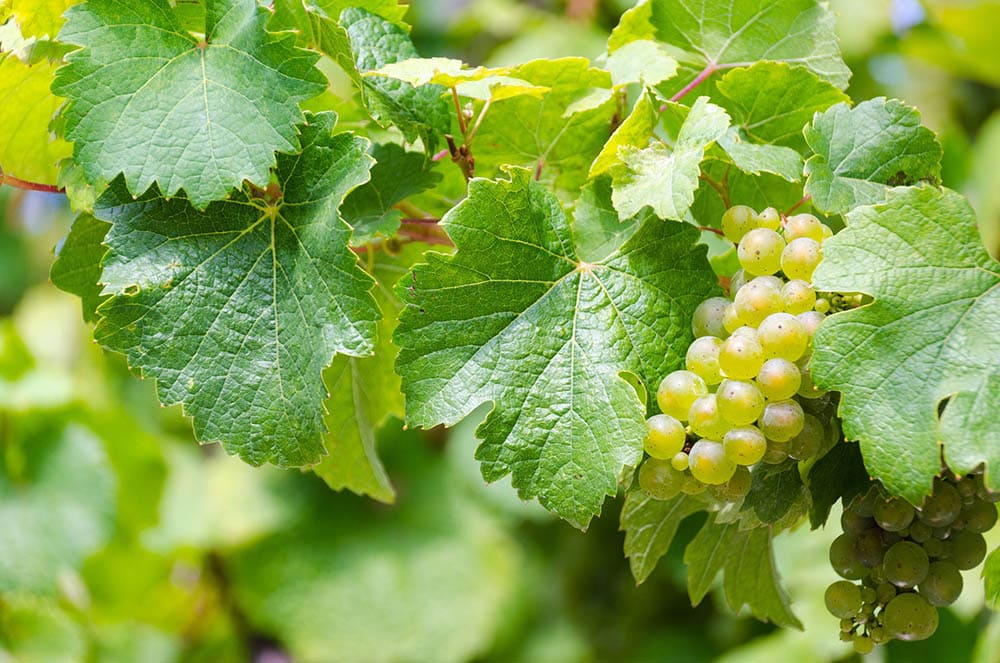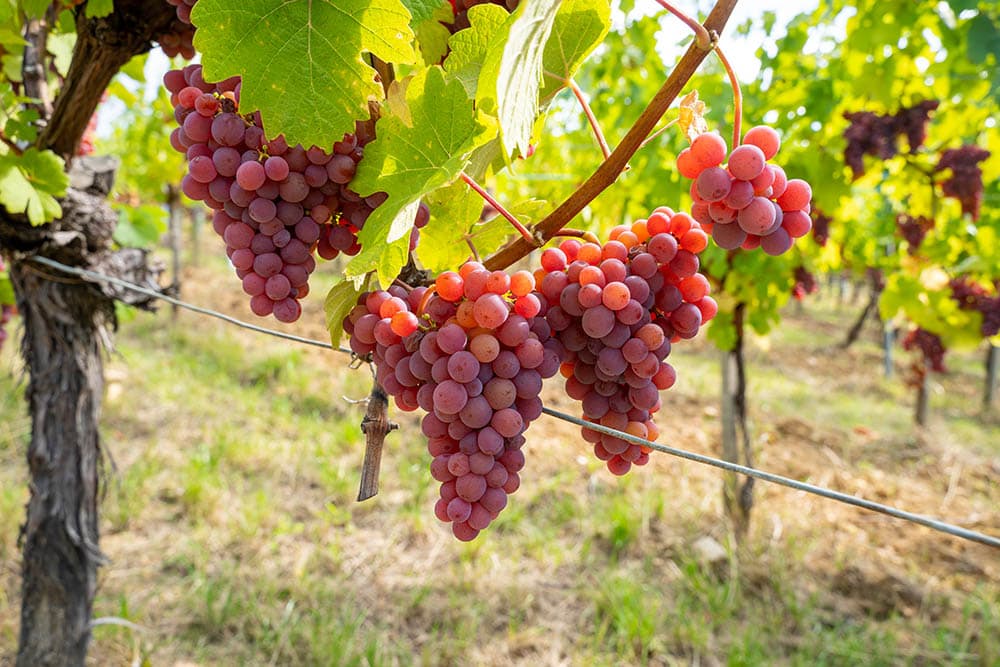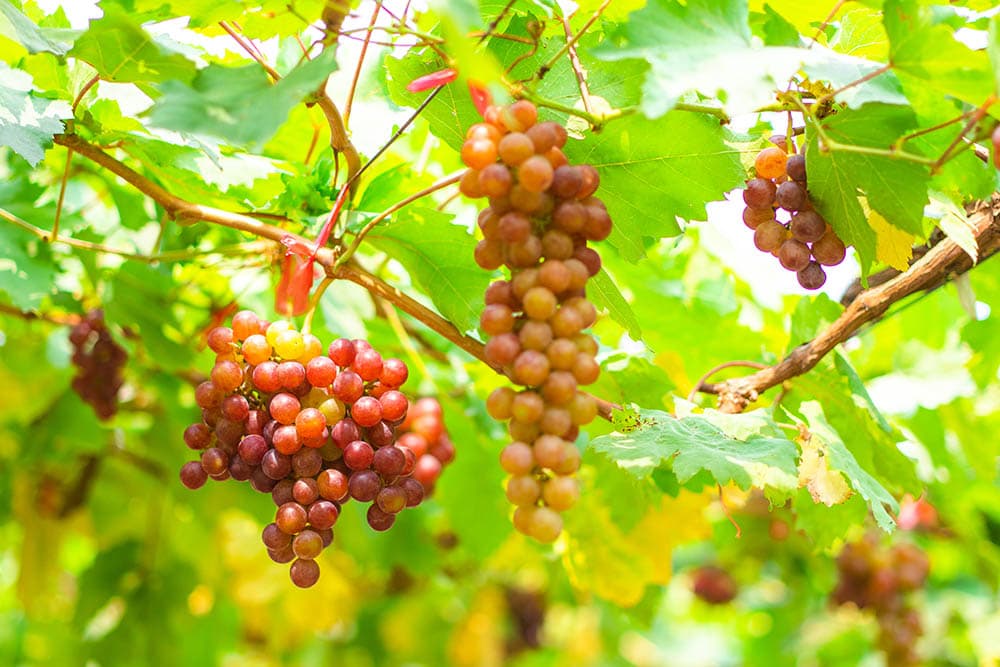15 Different Types of Grapes (With Pictures)
-
Pete Ortiz
- Last updated:

Grapes are a sweet and succulent fruit that not only makes for a great breakfast or smoothie ingredient but is responsible for great-tasting wines and savory desserts. But did you know that there are over twenty different types of grapes? Grapes are grown in different areas of the world, and they come in different colors, shapes, and flavors. Let’s discuss some of the most popular ones.
The 15 Different Types of Grapes
1. Champagne

Champagne grapes are a popular grape variety for eating. Many people might mistake it for the French sparkling wine grapes – but they have no association. Champagne grapes are tart with a bit of sweetness, and they are also some of the smallest grapes. These grapes are a great snack for people who don’t like sweets because of their bittersweet flavor. These grapes can’t be used to make wine, but they make for tasty snacks.
| Growing Locations: | Europe and California |
| Growing Months: | Mini |
2. Riesling

Riesling grapes are typically grown in cooler climates and can be used to make dessert wine-sweet, dry, or table wine. The sugars in these grapes are balanced by the natural sweetness and natural acidity of the grape. These grapes taste fantastic when made into non-alcoholic wine. Riesling grapes are one of the most popular varieties of wine grapes because of the love of the wine that they can make (and its popularity).
| Growing Locations: | France, Germany, Austria, Canada |
| Growing Months: | September-August |
3. Fry Muscadine

Fry muscadine grapes are large and have a distinctive taste. These grape varieties are also very cold-hardy and disease-resistant, which makes them easier to grow compared to many other varieties.
They are also heat-resistant, and their skin is also edible. This makes them much more enjoyable to eat, unlike other varieties that may have tougher chewy skins. They are similar in size to cherry tomatoes and have a tangy sweetness that’s easy to love. Once ripe, they turn a golden-orangish hue from their initial greenish color.
| Growing Locations: | Southern parts of the US |
| Growing Months: | September-November |
4. Sweet Jubilee

| Growing Locations: | California |
| Growing Months: | July-September |
Sweet jubilee grapes, large oval black grapes, have a crisp grape flavor and a firm texture. This is one of the seeded grape varieties that grows very large compared to other grape types. They are light yellow with orangish shades depending on the season. These grapes can be eaten raw or lightly grilled to add a fruity kick and flavor to your salad or a savory meal.
5. Pinot Noir

Pinot Noir, a champagne grape variety that was originally grown in Burgundy in France, is now a very popular choice for many, many, wine drinkers. These grapes can now be grown all over the globe. Pinot Noir grapes take time and expertise to grow but are well worth the effort. These grapes are perfect for winemaking because they have rich aromas and flavors such as caramel, earthiness, and ripe cherry.
| Growing Locations: | France and California |
| Growing Months: | September-August |
6. Lemberger

Lemberger grapes have a brilliantly purple hue and a spicy aftertaste. This dark-skinned red wine grape variety is late-ripening and known for its spicy flavor. It’s often used to make dark tannic wines that have subtle spices. These plump grapes are characterized by a tannic berry aroma and a dusty-blue hue.
| Growing Locations: | Canada, Germany, New York City |
| Growing Months: | September-August |
7. Valiant

The valiant is a less popular variety that is sweet and think-skinned. These grapes can withstand freezing temperatures and hard soil conditions. This makes them very easy to grow even in Alaska.
These cold-weather grapes are similar to concord grapes, which have high-sugar flesh but easy-to-remove skin. They aren’t as stringy and are bigger than your average table grape. Valiant grapes are sweeter than others, but they can still be used for juicing, jams and as a typical table fruit.
| Growing Locations: | Canada, Alaska |
| Growing Months: | September-November |
8. Moon Drops

These grapes go against the grain when it comes to appearance. Moon drops are a purple grape variety with nearly black skin. These grapes are tubular-shaped and have a firm texture.
They can be refrigerated for up to 17 days. Moon drop grapes taste similar to grape jelly but are much sweeter than grape jelly. These grapes were developed by the Grapery in Bakersfield and their unique shape is hard to miss.
| Growing Locations: | California |
| Growing Months: | September-November |
9. Crimson Seedless

These red grapes are easy to recognize and are some of the most popular grapes eaten in the US. Crimson seedless grapes are long-lasting and have a pleasant and subtle tartness. They can sometimes have a greenish tint, but they are typically pale brick reddish in color. They also have thick skin and tasty juice that makes them great for snacking and use in salads.
| Growing Locations: | California |
| Growing Months: | November-August |
10. Kyoho

Kyoho is a widely renowned Japanese grape that can grow as large as a plum. The name comes from the Japanese term that means “giant mountain grape”. These grapes can be used for dessert, in traditional Japanese cocktails, or juiced. Kyoho grapes are very similar to Concord grapes in flavor and texture. They are dark purple in color and have large, edible seeds.
| Growing Locations: | Japan |
| Growing Months: | July-August |
11. Cotton Candy

Who knew there’d be a grape variety named after cotton candy? The cotton candy grape varieties taste just like grape candy – which explains their name. These grapes were developed in California by a horticulturist and have grown in popularity ever since.
The average grape has lower sugar and calories than cotton candy grapes. These grapes can be very healthy, but they should be eaten in moderation due to their sugar content.
| Growing Locations: | Central California |
| Growing Months: | September-August |
12. Concord

Concord grapes (yes, just like the jelly brand) are an heirloom variety of grapes that is known for their distinctive dark, sweet grape flavor. Ephraim Wales developed this variety in Concord, Massachusetts in 1850. These grapes are delicious and have large round seeds. They also have easy-to-peel skins.
| Growing Locations: | New York, Washington, Michigan |
| Growing Months: | September-August |
13. Dominga

Dominga grapes are well known for their beautiful pale-yellow color and sweet flavor profile. These delicious medium-sized grapes have thin skin and are easy to eat. They have fewer seeds than most other seeded grapes and make a great snack choice. Considered a table grape, the Dominga grape has a pleasant flavor and boasts quite a few health benefits.
| Growing Locations: | Mediterranean regions |
| Growing Months: | March-April |
14. Gewurztraminer

These white grapes have a dusty pinkish-red color with thin skin. Gewurztraminer grapes are grown mostly for wine but can also be used as table grapes. They do best in cooler climates and are typically grown in Europe in countries including Germany, France, the Netherlands, and Austria. Although they are about medium in size when compared to other grapes, they boast a lot of flavor.
| Growing Locations: | Germany, France, The Netherlands, Austria |
| Growing Months: | September-July |
14. Sultana

The Sultana grapes are sweet light green (or “white”) grapes that originated in the Ottoman Empire. These small, thin-skinned grapes are often eaten dried and perfect for desserts and sauces. Sultana grapes have a concentrated, sugary flavor that is sweet and earthy. These grapes are all the rave in the Middle East, California, and many parts of Europe.
| Growing Locations: | Australia, California, Turkey |
| Growing Months: | September-July |
15. Flame Seedless

Flame Seedless grapes have a beautiful crimson color and thick skin. They’re a hybrid of Thompson and Cardinal seedless grape varieties. These tasty grapes have a sweet taste and are grown in large clusters in parts of India. Because of their sweetness, long shelf life, and seedlessness, they’re one of the most widely farmed table grapes in India and the Middle East. They’re also popular in Europe.
| Growing Locations: | North India |
| Growing Months: | Sept-July |
In Conclusion
Grapes are a tasty fruit that can be used for a variety of food applications. Not only can they be eaten on their own, but they are also used to make wine, jams, sauces, and a number of snacks. So, if you’re looking to try a new grape variety for your dessert recipe, know that there is a large number to choose from.
Featured Image Credit: David Kohler, Unsplash
Contents


